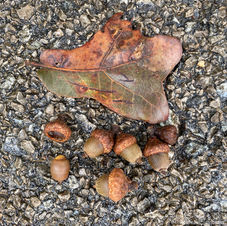Blackjack Oak
Quercus marilandica
Description:
The blackjack oak is a very tough tree that can grow in undesirable locations - poor soil, rocky soil, and/or dry soil. Drought tolerant. It is a small to medium sized oak, not growing nearly as large as other red oaks. Blackjack oak tolerates some of the worst soil conditions of all the eastern oak species. Acorns are small, but may be valuable to wildlife in areas where other oaks don't produce.
Distribution:
Southeastern US. West to Texas, north to extreme southern Iowa, east to New Jersey, south to the Florida Panhandle.
Habitat:
Dry, rocky, or poor soil
Leaf:
Leaves are thick, leathery, and irregular in shape. Generally with 3 oddly rounded lobes and shaped like a duck's foot, they may vary in shape and size considerably. Midvein and side veins protrude above the top surface of the leaf, and the leaf is pubescent (fuzzy), especially on the underside.
Gallery
Look-alike oaks:
Blackjack oak is very unique in appearance; however, the leathery leaves may resemble those of post oak from a distance. The bark and leaf shape will easily distinguish the two when observed up close.















